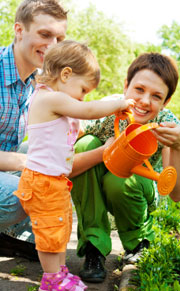
Let's Go Gardening
Each day, our kids are blasted with ads for greasy, cheesy, sugary, processed foods. It’s no wonder they turn up their noses when you present them with a bowl of  veggies. Unless, of course, the vegetables are deep-fried and doused in Ranch dressing.
veggies. Unless, of course, the vegetables are deep-fried and doused in Ranch dressing.
One way to get kids involved in making healthy choices is to bring them back to square one – and that’s in the garden. When children play a role in growing their own food, they’re more likely to eat their fruits and vegetables and learn a new sense of responsibility.
“Gardening teaches kids about being care givers,” said Gwenne Hayes-Stewart, executive director of Gateway Greening, via e-mail. Her organization promotes gardening partnerships for community development. “Consequences of poor care are evident nearly at once. Just as apparent are the consequences of paying attention to what plants need. Kids pick up on this quickly. No water, the plant dies. Too much water, the plant struggles. Making sure to check the soil first, and bingo, success!”
You still have time to introduce your kids to the benefits of gardening this summer. Although it’s getting too late to plant many fruits and vegetables, you’re only a few steps away from a delicious harvest this autumn.
Said Debbie Tolstoi of Garden Heights Nursery by e-mail, “In August, sow seeds for the fall season such as spinach, carrots, collards, kale, lettuce, beets, turnips, radish, cilantro and dill. Broccoli, cabbage and cauliflower plants should be available in nurseries in late August or early September.”
I know what you’re thinking, because I’ve thought it myself – planting and maintaining vegetables sounds like too much work. Believe me, I definitely don’t have a green thumb – it’s more like the black thumb of veggie death. However, Tolstoi had some excellent tips that make planting a garden a snap:
- Plant your vegetables in a good potting mixture.
- Give your vegetables six to eight hours of full sun each day.
- Water plants on a regular basis, especially if they’re grown in containers.
- And “fertilize bi-monthly with a non-burning organic fertilizer throughout the growing season to add back some of the minerals that get washed out by watering.”
Even if you have the ambition to garden, you might think a home garden is out of your family’s reach because you have an apartment or small backyard. Guess again – you and your kids have a variety of options to grow fresh food at home, even if your farmland is nothing more than a concrete patio.
“Growing vegetables can be a rewarding family experience no matter how small the space,” noted Tolstoi. “Try growing some of the smaller varieties of tomatoes, such as Patio Tomatoes, Green Zebra Heirloom, Sugary Grape, Roma, Micro Tom or Husky Red Cherry in containers, window boxes or the upside-down Topsy Turvy Tomato Planter.”
In addition, “Other vegetables that are suited to grow in containers and window boxes are peppers, eggplant, bush beans, Swiss chard. Climbing vegetables such as pole beans, scarlet runner beans, gourds and cucumbers can be trained to grow on a fence or trellis.”
If these options don’t work for your family and you still want to introduce your children to gardening, take a look around your neighborhood. Gateway Greening has community gardens across the metro area where your kids can get their hands dirty and you can build strong connections with your neighbors.
According to Hayes-Stewart, “If parents are interested in joining a community garden with their children, they can contact Gateway Greening for the nearest school or community garden at 314-588-9600. There are more than 200 gardens so it is likely there is one near any city resident. They can also come to the Bell Garden at Bell and Vandeventer any Saturday from 9 a.m. to 1 p.m. They can also check our Facebook page, Gateway Greening, or call to be placed on our e-blast list to see what is scheduled for Saturday demonstrations during the growing season.”
Growing your own produce is an effective way to get even the pickiest of eaters to try a wide variety of fruits and vegetables. Even my 3-year-old drama queen will chow down on zucchini without throwing a fit since she picked it fresh from the garden. By gardening together, you plant the seed for a lifelong love of natural foods and help your children build skills they can use long into adulthood.
By Nicole Plegge, Lifestyle Blogger for SmartParenting

Metro East mom Nicole Plegge has written for STL Parent for more than 12 years. Besides working as a freelance writer & public relations specialist, and raising two daughters and a husband, Nicole's greatest achievements are finding her misplaced car keys each day and managing to leave the house in a stain-free shirt. Her biggest regret is never being accepted to the Eastland School for Girls. Follow Nicole on Twitter @STLWriterinIL




















